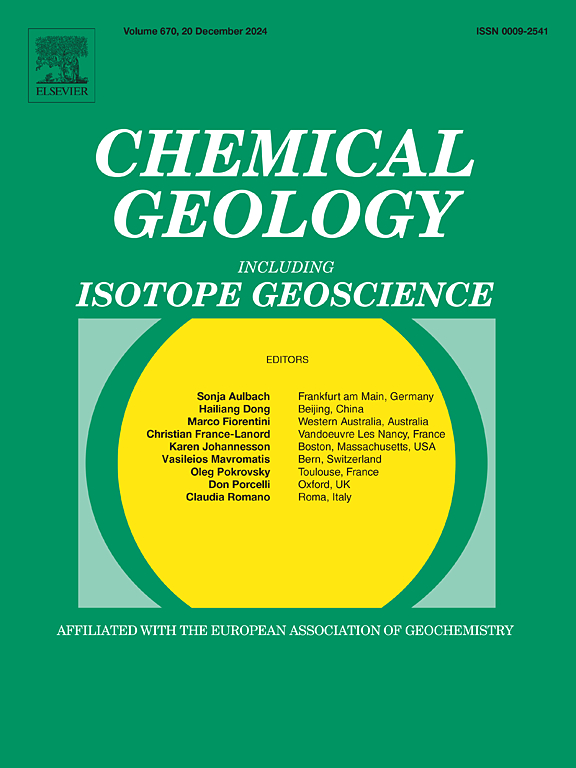Fluid evolution and halogen fractionation in orogenic belts: A comparative fluid inclusion appraisal in the Eastern Pyrenees
IF 3.6
2区 地球科学
Q1 GEOCHEMISTRY & GEOPHYSICS
引用次数: 0
Abstract
The physicochemical signatures of fluid-rock interaction, recorded in fluid inclusions, represent fundamental proxies for understanding the interplay between rock deformation, fluid migration, and ore deposit formation in the Earth's crust. Although fluid-rock interaction can take place simultaneously or sequentially both in the basement and the cover of collisional orogens, these two scenarios are generally investigated separately, thus precluding an integrated understanding of the processes involved. Here, we present a comprehensive study of the fluid evolution in the basement and cover rocks of the Pyrenees (SW Europe) by means of Geographic Information System (GIS)-assisted petrography, microthermometry, Electron Backscatter Diffraction (EBSD), Raman micro-spectroscopy, and Laser Ablation Inductively Coupled Plasma Mass Spectrometry (LA-ICP-MS) microanalysis of individual fluid inclusions. The investigated fluids are sampled from giant quartz veins, which are tens of meters wide and up to several kilometres long. Two-phase aqueous fluid inclusions hosted in the basement (Canigó and Cap de Creus massifs) and cover rocks (Roc de Frausa massif) show significant variations regarding their homogenization temperature (Th), salinity, and chemical composition. Basement-hosted H2O-NaCl-CaCl2 fluids have Th and salinity ranging between 190 and 220 °C and 12–16 wt% equivalent (eq.) NaCl in the Canigó massif, and between 190 and 260 °C and 16–20 wt% eq. NaCl in the Cap de Creus massif. Conversely, Th of 180–240 °C and salinity of 4–7 wt% eq. NaCl were obtained for H2O-NaCl cover rock-hosted fluids in the Roc de Frausa massif. Fluid salinity, cation concentrations, and halogen ratios suggest that basement-hosted fluids represent residual basinal brines that originated from seawater which underwent variable degrees of evaporation and organic matter interaction. In contrast, cover rock-hosted fluids represent seawater-like precursor fluids that record strong organic matter interaction without significant evaporative halogen fractionation. The data suggest that neither basement- nor cover-hosted fluids were released at depth from magmatic or metamorphic fluids, which agrees with geological constraints of the investigated areas. However, fluids from both basement and cover rocks infiltrated deep into the subsurface, as revealed by their variable metal and halogen concentration suggesting compositionally stratified fluid compositions at depth. Our data and conclusions differ from fluid inclusion studies reported for other giant quartz vein systems worldwide, suggesting that different fluid origins and evolution histories may drive the formation of these large quartz accumulations. Moreover, the large variations of the Br/Cl, I/Cl, and Br/I ratios show that halogen ratios should be used with caution: they are excellent tracers of the fluid evolution history, but may not provide a straightforward fluid origin classification.
造山带流体演化与卤素分异:东比利牛斯山脉流体包裹体对比评价
流体包裹体中记录的流体-岩石相互作用的物理化学特征是了解地壳中岩石变形、流体迁移和矿床形成之间相互作用的基本指标。虽然在碰撞造山带的基底和盖层中流体-岩石相互作用可以同时或依次发生,但这两种情况通常是分开研究的,因此无法对所涉及的过程进行综合理解。本文采用地理信息系统(GIS)辅助岩石学、显微测温、电子背散射衍射(EBSD)、拉曼显微光谱和激光烧蚀电感耦合等离子体质谱(LA-ICP-MS)对欧洲西南部比利牛斯山脉基底和盖层的流体演化进行了全面研究。所研究的流体是从巨大的石英脉中取样的,这些石英脉宽数十米,长数公里。基底(Canigó和Cap de Creus地块)和盖层(Roc de Frausa地块)中的两相含水流体包裹体在均一温度(Th)、盐度和化学成分方面存在显著差异。基底层含H2O-NaCl-CaCl2流体的Th和盐度范围在Canigó地块为190 ~ 220℃,NaCl当量为12 ~ 16 wt%; Cap de Creus地块为190 ~ 260℃,NaCl当量为16 ~ 20 wt%。相反,Roc de Frausa地块中H2O-NaCl覆盖岩石流体的温度为180 ~ 240°C,盐度为4 ~ 7 wt% eq. NaCl。流体盐度、阳离子浓度和卤素比表明,基底流体代表来自海水的残留盆地盐水,这些盐水经历了不同程度的蒸发和有机质相互作用。相比之下,盖层岩石流体代表了类似海水的前驱流体,记录了强烈的有机质相互作用,没有明显的蒸发卤素分馏。资料表明,岩浆或变质流体在深部既没有释放基底流体,也没有释放盖层流体,这与调查地区的地质限制条件一致。然而,来自基底和盖层岩石的流体都渗透到地下深处,其变化的金属和卤素浓度表明,流体组成在深度上是分层的。我们的数据和结论与世界上其他巨型石英脉系统的流体包裹体研究不同,表明不同的流体来源和演化历史可能驱动这些大型石英聚集的形成。此外,Br/Cl、I/Cl和Br/I比值的巨大变化表明,卤素比值应谨慎使用:它们是流体演化史的优秀示踪剂,但可能无法提供直接的流体来源分类。
本文章由计算机程序翻译,如有差异,请以英文原文为准。
求助全文
约1分钟内获得全文
求助全文
来源期刊

Chemical Geology
地学-地球化学与地球物理
CiteScore
7.20
自引率
10.30%
发文量
374
审稿时长
3.6 months
期刊介绍:
Chemical Geology is an international journal that publishes original research papers on isotopic and elemental geochemistry, geochronology and cosmochemistry.
The Journal focuses on chemical processes in igneous, metamorphic, and sedimentary petrology, low- and high-temperature aqueous solutions, biogeochemistry, the environment and cosmochemistry.
Papers that are field, experimentally, or computationally based are appropriate if they are of broad international interest. The Journal generally does not publish papers that are primarily of regional or local interest, or which are primarily focused on remediation and applied geochemistry.
The Journal also welcomes innovative papers dealing with significant analytical advances that are of wide interest in the community and extend significantly beyond the scope of what would be included in the methods section of a standard research paper.
 求助内容:
求助内容: 应助结果提醒方式:
应助结果提醒方式:


